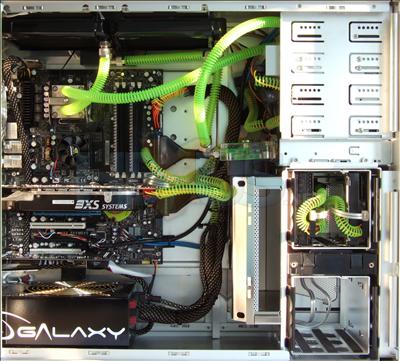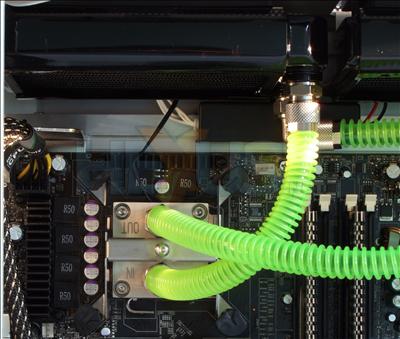What's inside?
Popping off the side and the high-powered innards are shown.
Remember the vented section on the previous page? That's where the system's hard drives, which comprise of a Western Digital 150GB Raptor X for booting and 750GB Seagate 7200.10 for storage, reside. Cabling is tidied by using sheaths which are pulled through the back of the removable cage and the enclosed SATA cables connected to the board.
There's space for an additional four drives, although you may have to dispense with the gaudy-coloured sheathing. The chassis design allows for a 120mm fan to be sandwiched between the drive cages and SCAN has sensibly added one in between.
To the left of the drives is an integrated 120mm fan that draws cooler air from the outside and pushes it across the graphics card(s) and out through the back of the chassis. You can see why the side panel featured the open section now.
Powering this high-end system is an Enermax's premier consumer-level PSU. The Galaxy 1000W has more than enough juice to cope with significant extra load, and the generously-equipped 12V rails to supply clean voltage to the CPU and graphics card(s). It's also quiet, which is always appreciated.
Moving on up, as M People would say, the guts of the system is a reference motherboard based on NVIDIA's latest core logic, the 680i. Suffice to say, we reckon it will become the must-have core-logic for enthusiasts who hanker after some Core 2 love.
The next photography stop on the 3XS Triad tour is, inevitably, the main draw. This SKU has been outfitted with an XFX GeForce 8800 GTX 768MiB graphics card. Massive shading power, bags of memory bandwidth and DX10 compliance makes it the world's fastest consumer graphics card. We could devote an entire, in-depth review to it, which is exactly what we did, so head on over to our technical evaluation here.
With NVIDIA designing this enthusiast-class motherboard there's enough space to add a second card for SLI action, and SCAN gives you the option at the time of purchase. The cooler on the GTX card is very quiet, but going hand in hand with the design ethos here, it really should have been watercooled. However, the lack of watercooling may be a case of unavailable blocks at present.
We recently took an exhaustive look at Intel's Core 2 Extreme QX6700 quad-core CPU over here and concluded it was the fastest CPU, when evaluated over a cross-section of metrics, to hit the market. SCAN's judiciously decided that it fits in the with Triad's raison d'etre and we agree. A Core 2 Extreme X6800 may well be faster in gaming but, on balance, we'd opt for the quad-core Kentsfield any day.
The chassis has space for a couple of 120mm fans at the very top and that area has been used to install an internal Alphacool watercooling kit. Two Black Ice radiators line the top, cooled by a couple of 120mm fans directly above, and the associated reservoir is situated in the uppermost 5.25" bay which you saw at the front of the chassis. The pump is located a little way down. It's a lot of effort for simply cooling the overclocked CPU (final clockspeeds to be confirmed), so, once again, we'd like to see the GPU cooled via the kit as well.
Corsair's Dominator RAM (PC8500, EPP) is the memory of choice, so it's a high-quality affair all around. A single 120mm fan, situated at the back, pulls heat away from the CPU block and keeps temperatures in check.
SCAN's building department seems to be in a festive mood already. The Triad Tian Di Hui is outfitted with a couple of Sharkoon CCFL that light up the UV-reactive additive to give the chassis a distinctive look. Too bad there's no window to show it all off.
SCAN's used an eclectic mix of very high-end components and integrated them into a decent chassis. Spec.-wise, there's not much we'd change; each component is at or near the top of its field with respect to performance. We'd liquid-cool the GPU and the mainboard's chipset bridges but that's about it.
Value for money?
There's little to criticise with regards to the quality of componentry and, by extension, performance. However, does the SKU offer value for money?Totting up the price of the individual parts, many of which an informed enthusiast with a large budget for the ultimate base unit would, we reckon, choose, we arrive at a buy-it-yourself price of around £2,950. That excludes warranty and building costs and SCAN's configurator lets you choose from practically every compatible product stocked by the etailer. £3,099 is an extremely high price to pay for a base unit with a single graphics card, sure, but given the choice of components and quality of construction, the asking price is reasonable, especially if you want a high-performance rig but are disinclined to build it yourself.
As a comparison, take a look at the specification (including bespoke chassis and 1kW PSU) with a similarly priced Alienware machine we took a look at a couple of months' ago. Of course, Alienware will have updated the specification but it shows the kind of market SCAN is aiming at with its 3XS line.
Ensuring even-handedness, and if you don't need super-cool chassis that retail at £200 and kilowatt PSUs that cost even more, the likes of MESH usually offer high-end systems with a better package than SCAN. That, however, misses the point of the Triad, which is ultimate performance coupled with ultimate style - a wow factor, if you will - that's missing from bog-standard (but very good value-for-money) MESH SKUs.
SCAN informs us that it ships all relevant original CDs with its 3XS machines, including Windows XP. Further, a software-recovery DVD is included should your system's software require setting back to factory-fresh state.
Warranty
SCAN includes a 2-year warranty with this SKU, with the first year on-site (parts and labour included) and the second RTB which covers labour costs only. Average turnaround is quoted as 3 working days. The warranty is only valid for the original purchaser of the machine and selling it on even within the warranty's life renders it void, sadly. We find the warranty a little stingy for a super-deluxe SKU and would rather SCAN market it at, say, £3249 and offer a 3-year onsite, transferrable warranty as standard, with the option of reducing it to the present 2 years with an associated reduction in price. To the kind of buyer who can afford such a system, there's not too much difference between £3249 and £3099, and seeing a 3-year onsite warranty as standard will definitely be viewed as a positive. This is more a marketing issue than engineering, though.Summary
You'll need to add a monitor, preferably a 24in model with 1920x1200 resolution a minimum, speakers, input devices and, if feeling particularly flush, a second GeForce 8800 GTX 768MiB card. We'd imagine a total PC price of somewhere around £4,000, or £4,500 with SLI'd cards. As this hack is not tired of reporting, that's worth more than his car, but there's definitely a market out there that can afford and justify such a price tag for a 'dream PC'. If you're one of them the Triad is an appealing proposition.Let's now see just how fast it is!












